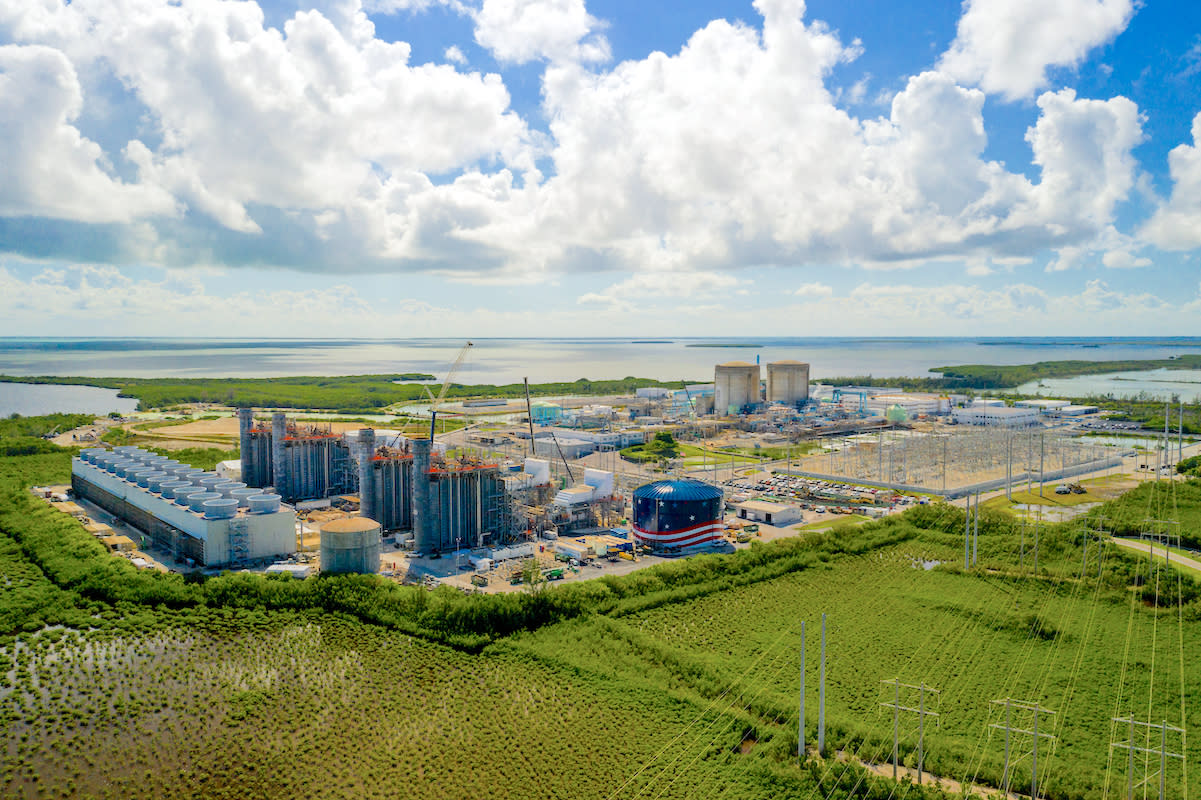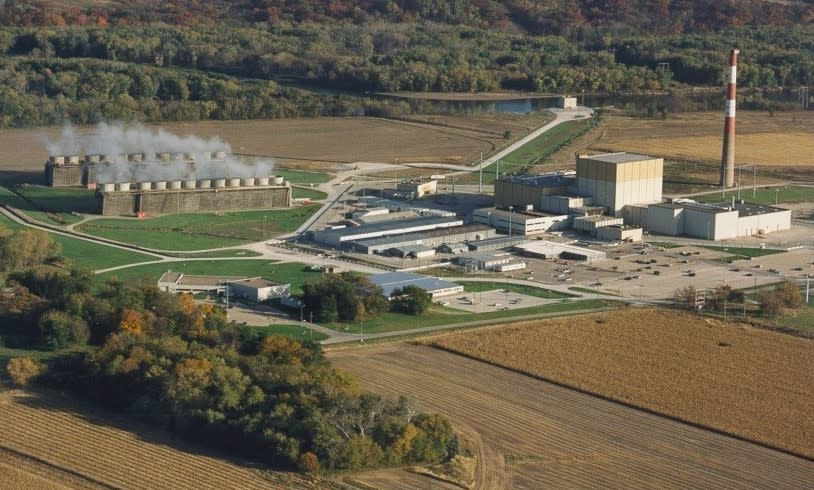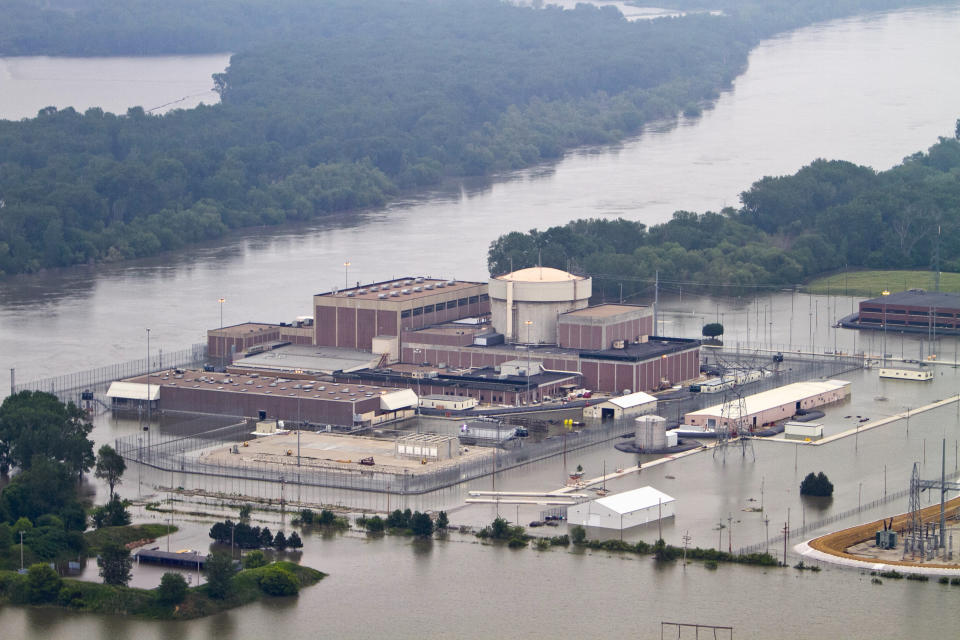Can Aging U.S. Nuclear Power Plants Withstand More Extreme Weather?

To reach its climate goals, the Biden administration aims to extend the lives of U.S. nuclear reactors. But a new report finds regulators have not studied whether increasingly extreme weather could threaten the safety or viability of power plants largely built in the 1970s and 1980s.
On August 10, 2020 a powerful derecho windstorm blasted the Duane Arnold nuclear power plant in Iowa. Up to 130 mile-per-hour winds caused a power outage and knocked over the 50-year-old plant’s wooden cooling towers, which triggered an automatic shutdown of the reactor and a switch to backup generators to power its cooling system. The U.S. Nuclear Regulatory Commission (NRC) concluded the plant’s multiple layers of defense had avoided any risk of releasing radioactive material, but the reactor was never restarted. The plant had been slated to close, and its owner decided not to repair the damage.
“A weather-related event prematurely and permanently shut down the Duane Arnold,” says Jeff Mitman, a nuclear risk consultant and a former NRC engineer now involved in a campaign to highlight safety risks at aging nuclear plants. He points to Duane Arnold as an example of how such plants can be vulnerable to extreme natural hazards that may be exacerbated by climate change.
The country’s 54 nuclear power plants still in operation were designed to be resilient to numerous outside threats, including the most extreme weather-related events deemed feasible based on the historical record, and even beyond. But most plants were built more than 40 years ago, and a new investigation finds these plants may yet be vulnerable to unprecedented hazards fueled by climate change, at a time when many experts say nuclear power is needed to keep emissions from fossil fuels in check.
According to the report released earlier this month by the U.S. Government Accountability Office (GAO), the investigative arm of Congress, every nuclear plant in the country is located in an area where climate change is set to worsen flooding, heat, storms, wildfires, extreme cold, or some combination. However, it found that the NRC — which is responsible for U.S. nuclear safety — has not conducted the analyses necessary to know whether nuclear power plants are prepared for those changing conditions.
The report did not demonstrate that any plants are necessarily vulnerable to these hazards, which would require a plant-by-plant analysis. But it found the NRC has not adequately addressed whether more extreme weather could force plants to shut down or lower power output more frequently, or pose a safety risk.

The findings could influence debates about the future of the country’s aging fleet of nuclear reactors, which the Biden administration is aiming to keep online for as long as possible to help reach its goal of net-zero emissions by 2050. Nearly every U.S. nuclear reactor has already had its operating life extended to 60 years, but reaching U.S. climate goals would mean keeping many plants online even longer. Eleven plants are currently in different stages of the relicensing process.
In its response to the GAO report, the NRC said that, while its licensing process does not currently consider climate change, existing protections are so conservative that they are sufficient to keep the country’s reactors protected from “any plausible natural hazard and combinations at a site for the licensed operational lifetime of the reactor, including those that could result from climate change.” But an NRC spokesperson told Yale Environment 360 the agency now plans to review U.S. nuclear safety in light of climate hazards identified in the recent National Climate Assessment, which could affect decisions on licensing.
U.S. nuclear power plants are exceedingly well-protected facilities, with the reactors at their core defended by redundant safety systems designed to withstand any number of extreme circumstances, from earthquakes to terrorist attacks. But even well-secured plants can be affected by extreme weather.
As at Duane Arnold, storms can cause damage or bring about power outages that force a shift to backup power to run the safety systems required to keep reactors cool. Fires can also cause damage or prevent workers from reaching the facility. Extreme heat can raise the temperature of the water that plants use in their cooling systems, forcing them to reduce power, while drought can limit the supply of water. Nuclear plants are also usually built near waterways or coastlines to ensure access for cooling, exposing them to potential flooding.
“A lot of it comes down to water,” says Erin Sikorsky at the Center for Climate and Security, a think tank in Washington D.C. “Either having too little water or too much water.” She points to the example of nuclear reactors in France in 2022, some of which were forced to reduce power as drought and a summer heat wave limited their use of river water to keep cool. There is no consensus on how climate change has already affected nuclear power plants globally, but one researcher found an increasing rate of reactor outages linked to climate-related disruptions since 1990. The researcher projected around 1 percent of nuclear energy generation would be lost to climate-related disruptions by mid-century.

In the U.S., nuclear power plants appear to have managed extreme weather with even less disruption so far. According to a report by the Electric Power Research Institute, a nonprofit energy research group, U.S. operators reported 120 weather-related events that led to a reduction in generation between 2011 and 2020. Together these events led to the loss of less than 0.1 percent of the total power U.S. reactors generated during that period. The report thus concluded weather had an “essentially negligible” impact on nuclear power generation, and that it remains the most reliable of any zero-carbon electricity source. Given the extreme conditions considered when plants were designed, it also concluded there was “no evidence” extreme weather exacerbated by climate change posed any safety risk not already accounted for by the existing nuclear licensing process.
Jessica Lovering at the Good Energy Collective, a progressive pro-nuclear group, says operators of nuclear power plants may have accounted for climate hazards. But she says it would be reasonable for the NRC to look more explicitly at them, even if it proves to be overkill: “We don’t know if it’s a problem.”
This uncertainty persists despite a detailed reassessment of natural hazards at U.S. nuclear plants the NRC carried out several years ago. Following the Fukushima Daiichi nuclear disaster in Japan in 2011, which saw three reactors melt down after an earthquake and subsequent tsunami knocked out the backup power needed to cool them, the NRC requested U.S. plant operators reevaluate seismic and flooding hazards.
Spokespeople from the nuclear industry cite the reevaluation as an example of how they have taken climate change into account, but operators were not required to use climate projections in their analysis of flooding hazards, and it is not clear the extent to which they did, the GAO report found. Nonetheless, the reevaluation process identified 55 nuclear plants out of 61 then operating at which flooding hazards exceeded what the plants were designed to manage when they were built.
These updated flooding hazards were mostly due to increased precipitation, but also included exposure to river flooding, storm surge, or the potential failure of an upstream dam. However, responding to the report’s findings in 2019, the NRC commissioners voted 3 to 2 not to require operators to update protections to reflect these “beyond-design-basis events,” arguing existing measures were adequate. NRC Commissioner Jeff Baran wrote in a dissenting letter that the decision was “nonsensical.”
This debate is now playing out again in fights over the future of nuclear power plants as they reach the end of their design lives. Paul Gunter at Beyond Nuclear, an anti-nuclear advocacy group, argues continued vulnerability to climate hazards is a reason the NRC should deny relicensing applications at some plants, such as the North Anna Nuclear Generating Station in Virginia, where Gunter plans to specifically cite the GAO report’s findings on flooding. According to the report, around two-thirds of U.S. nuclear plants are in areas with high flood hazard.
Beyond Nuclear, along with a chapter of the Sierra Club, also cite climate change in their efforts to shut down the Oconee Nuclear Station in South Carolina. For decades, NRC whistleblowers, some of whom say they faced retaliation from the agency, have said the plant’s cooling systems would be vulnerable to a large flood wave in the extremely unlikely event of an upstream dam failure. The plant’s operator Duke Energy has improved flood protection to its cooling system, but those challenging the Oconee plant say Duke has not accounted for climate change increasing the risk of dam failure, and that the changes made to improve flood protection are inadequate. “We believe the existing regulations, framework, and processes are effective in maintaining the plants as new information emerges,” said a Duke Energy spokesperson.
At Turkey Point Nuclear Generating Station on Florida’s southeastern coast, a similar intervention has delayed the plant’s relicensing. The NRC in 2019 approved the plant’s bid to stay open for an additional 20 years, but environmental groups intervened, arguing the plant’s operators haven’t properly accounted for climate change. David Lochbaum, a former nuclear safety advocate at the Union of Concerned Scientists who was involved with the effort, says the operators’ projections of sea level rise forecast the water would stop rising in 2033, just two inches below the plant’s existing flood barrier. “The NRC accepted this bogus evaluation and granted the 20-year extension,” he says. The NRC suspended the relicensing extension in 2022 for further review.
Dozens of U.S. nuclear power facilities will face decisions in coming years on whether they will be shut down or receive license extensions. It may be that a new generation of smaller reactors are built to replace them. The House of Representatives in February passed a bipartisan bill that would ease permitting hurdles for these reactors, many of which could be operating decades from now in a much warmer world. But in any scenario, the country’s existing plants are set to play an important role in meeting climate targets. It is even more reason to be certain they are up to the task.
James Dinneen is a science and environmental journalist from Colorado, based in New York. Read more of his work at jamesdinneen.wordpress.com. Reporting for this story was supported by a grant from the Council for the Advancement of Science Writing and the Brinson Foundation.

